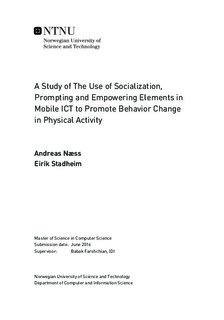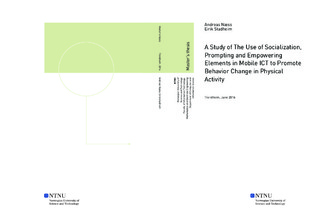| dc.description.abstract | Context: Only 32 % of the Norwegian population meet the recommended levels of physical activity. The consequences of inactivity is a cost not only concerning the subjects themselves, but also the population in general. Both absence from work and health care expenses have to be covered by the society. The use of Information and Communications Technology (ICT) has proven to be an effective way to increase PA.
Objectives: The objective of this research is to create a mobile ICT intervention based on social, prompting and empowering elements, and use this intervention to find out more about how the three different elements affect participation in the intervention. By social elements we mean both sociality using ICT, and sociality happening in real life without the use of ICT. By prompting we mean reminding the participants about the intervention. By empowering we mean letting the participants take control over their own intervention.
Methods: A smartphone application was designed and created. A group of 10 subjects used the application, before an evaluation was conducted, consisting of usability questionnaires and interviews. In-depth interviews were later conducted with five subjects to get data on how the different elements of the intervention worked. The development of the intervention was guided by the Social Cognitive Theory and Cognitive Evaluation Theory.
Results: The smartphone application Ludi was created. It is a social network for people who want to do physical activity together. The focus is on openness, so that people without a great network of friends can find people to be active together with. The results of our research support a social intervention, with focus on the interplay between sociality on the ICT device and real life sociality. Prompting is somewhat controversial; people said they did not like to get too many notifications on their phones. Social network-triggered prompts were preferred over typical system-generated reminders. People tended to like having control of their own intervention; however most people believed they might benefit from less control if the intervention was guided by a professional in the initial phase.
Conclusions: Social and empowering elements seemed to be working well in a physical activity intervention. Prompting could work if the content was relevant, especially social or context-aware prompts. The two theories used worked well to guide the development of the intervention. | |

